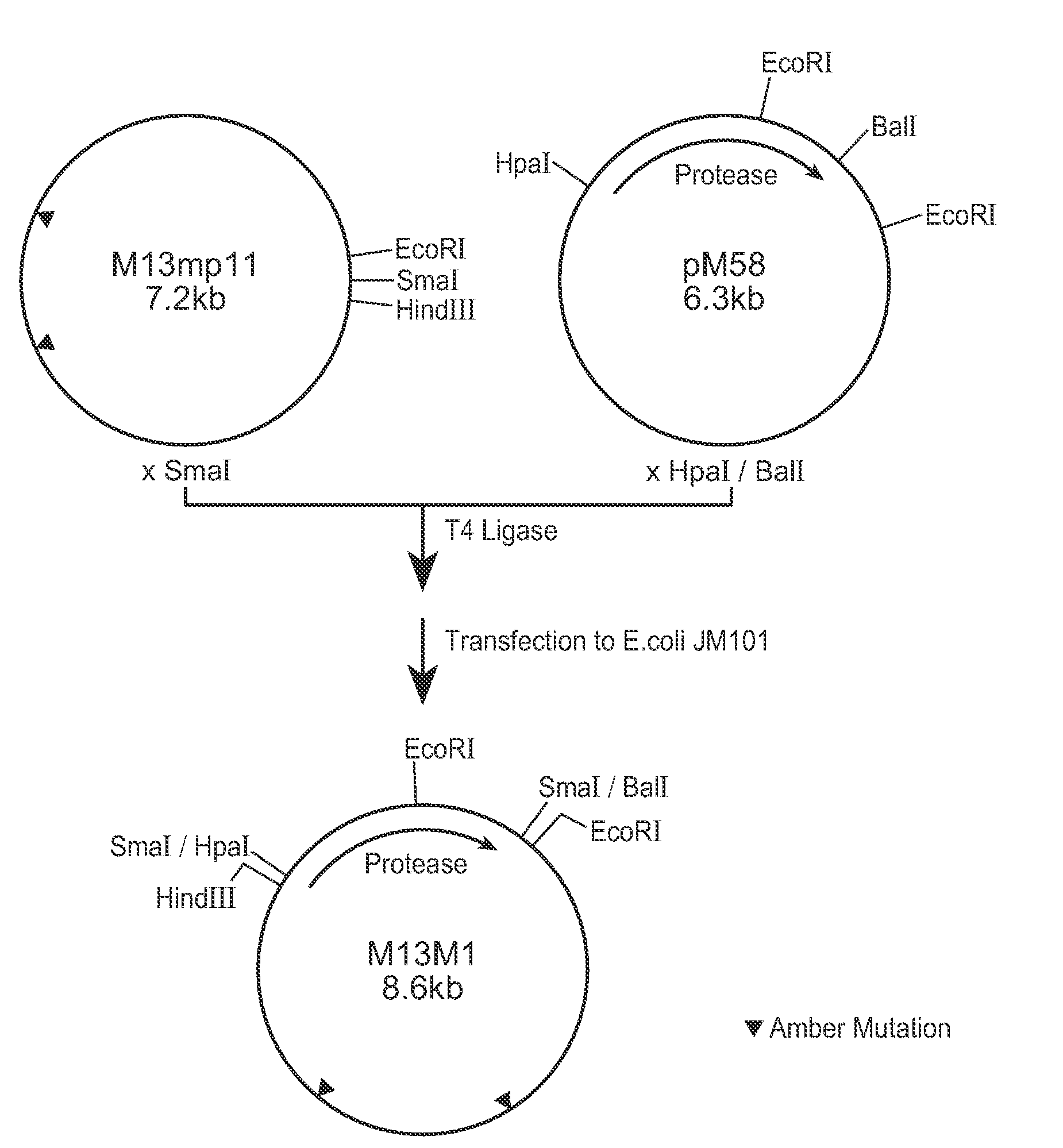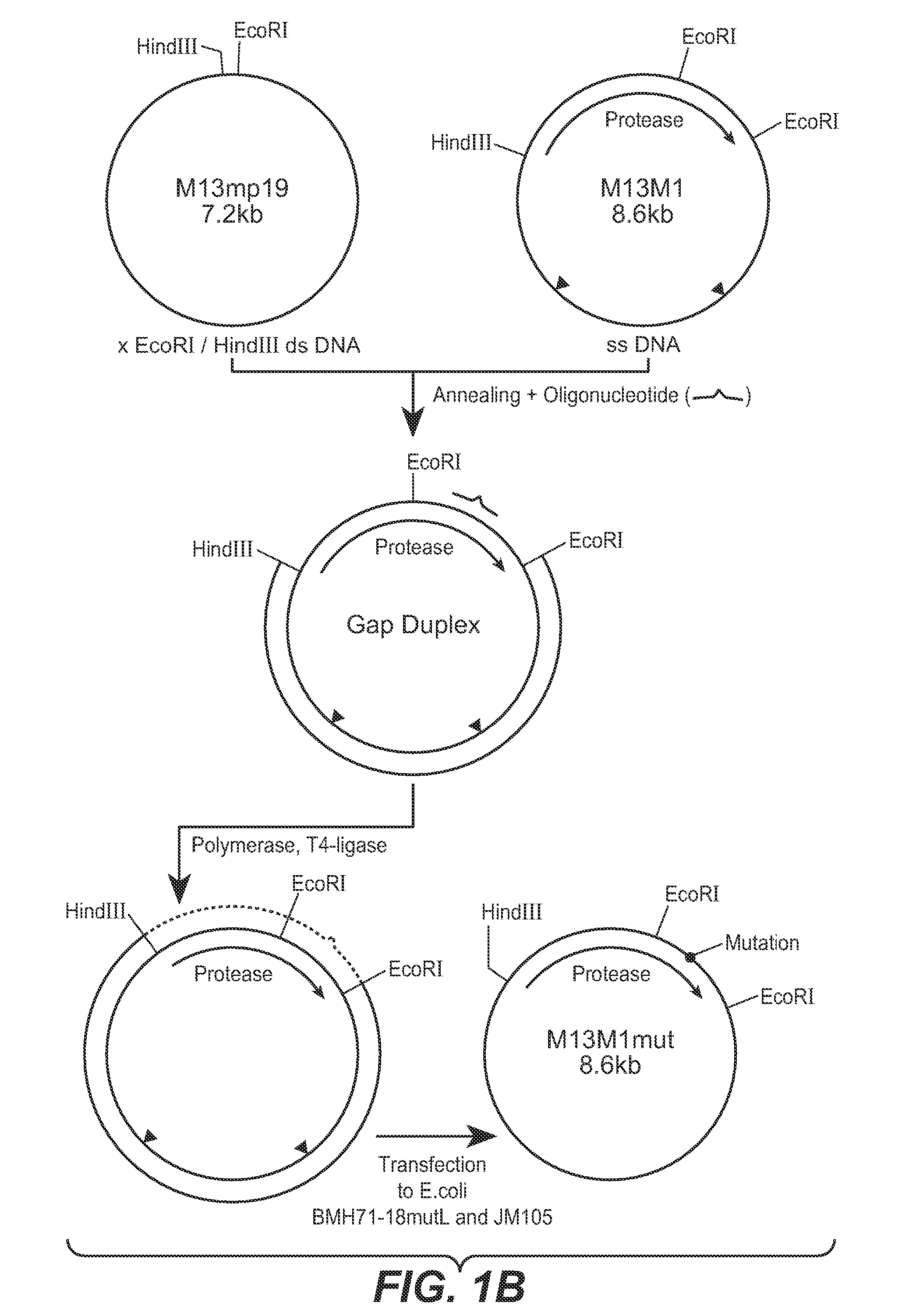Protease variants active over a broad temperature range
- Summary
- Abstract
- Description
- Claims
- Application Information
AI Technical Summary
Benefits of technology
Problems solved by technology
Method used
Image
Examples
example 1
Construction of PB92 Protease Mutants
[0132] In this Example, methods used to construct some of the PB92 mutants provided herein are described. The basic construct from which the mutagenesis work started, is referred to as “pM58,” which is described in EP 0283075 and in EP 571049. The strategy followed comprised three phases: [0133] A. Construction of Mutagenesis vector 13M1 [0134] B. Mutation Procedure [0135] C. Construction of pM58Eco and Subcloning of the Mutated DNA Fragment in the Vector
[0136] In addition, part D (“Production of PB92 Variants”) includes a description of the construction of various PB92 variants that were found to be useful in the present invention.
A. Construction of Mutagenesis Vector M13M1
[0137] The basic construct pM58 was digested with restriction enzymes HpaI and Bali. The 1400 bp fragment containing the PB92 protease gene was purified on low melting agarose as known in the art. Vector M13MP11 (See, Messing et al., Nucl. Acids Res., 9:303-321 [1981]) wa...
example 2
Mutants Expressed in B. clausii
[0157] In this Example, methods used to develop mutant proteases expressed in B. clausii PBT125 transformed using the expression vectors described in Example 1 are provided. This strain is a protease negative derivative of PBT110, which was obtained from strain PB92 using classical strain improvement methods, followed by screening for asporogenity and improved protease production.
Transformation Procedure of PB92 Protease-Negative Derivative: PBT125
[0158] The polyethylene glycol-induced protoplast transformation method of Chang and Cohen known in the art (See e.g., Chang and Cohen, Mol. Gen. Genet., 168:111-115 [1979]), with the following modifications, was used to transform B. clausii PBT125 with the expression vectors described in Example 1. First, protoplasts were prepared in alkaline holding medium containing 0.5 M sucrose, 0.02 M MgCl2, and 0.02 M Tris-maleate buffer (pH 8.0) to which 0.4 mg of lysozyme per ml was added. Then, the protoplasts w...
example 3
Analytical Techniques to Determine the Purity of Purified Proteases
[0161] In this Example, methods used to determine the purity of the purified proteases are described. Proteases were considered pure when a single band or peak was found by electrophoresis and high performance gel electrophoresis (HPLC), respectively.
[0162] Polyacrylamide gel-electrophoresis (PAGE) in the presence of sodium dodecyl sulphate (SDS) was conducted as known in the art (See, Laemmli, Nature, 227:680-685 [1970]). However, prior to denaturation of the protein samples by SDS at 100° C., inactivation of the protease activity was required, in order to prevent autodegradation. This was accomplished by incubation with phenylmethylsulfonyl fluoride (PMSF) (1 mM, 30 min, room temperature) or precipitation with trichloroacetic acid (TCA, 8%, 30 min, on ice). Native PAGE was carried out at pH 7.45 (gel buffer consisting of 20 mM histidine (His) and 50 mM 3-[N-morpholino]propanesulfonic acid (MOPS) in 5% polyacrylam...
PUM
| Property | Measurement | Unit |
|---|---|---|
| Temperature | aaaaa | aaaaa |
| Angle | aaaaa | aaaaa |
| Angle | aaaaa | aaaaa |
Abstract
Description
Claims
Application Information
 Login to View More
Login to View More - R&D
- Intellectual Property
- Life Sciences
- Materials
- Tech Scout
- Unparalleled Data Quality
- Higher Quality Content
- 60% Fewer Hallucinations
Browse by: Latest US Patents, China's latest patents, Technical Efficacy Thesaurus, Application Domain, Technology Topic, Popular Technical Reports.
© 2025 PatSnap. All rights reserved.Legal|Privacy policy|Modern Slavery Act Transparency Statement|Sitemap|About US| Contact US: help@patsnap.com



